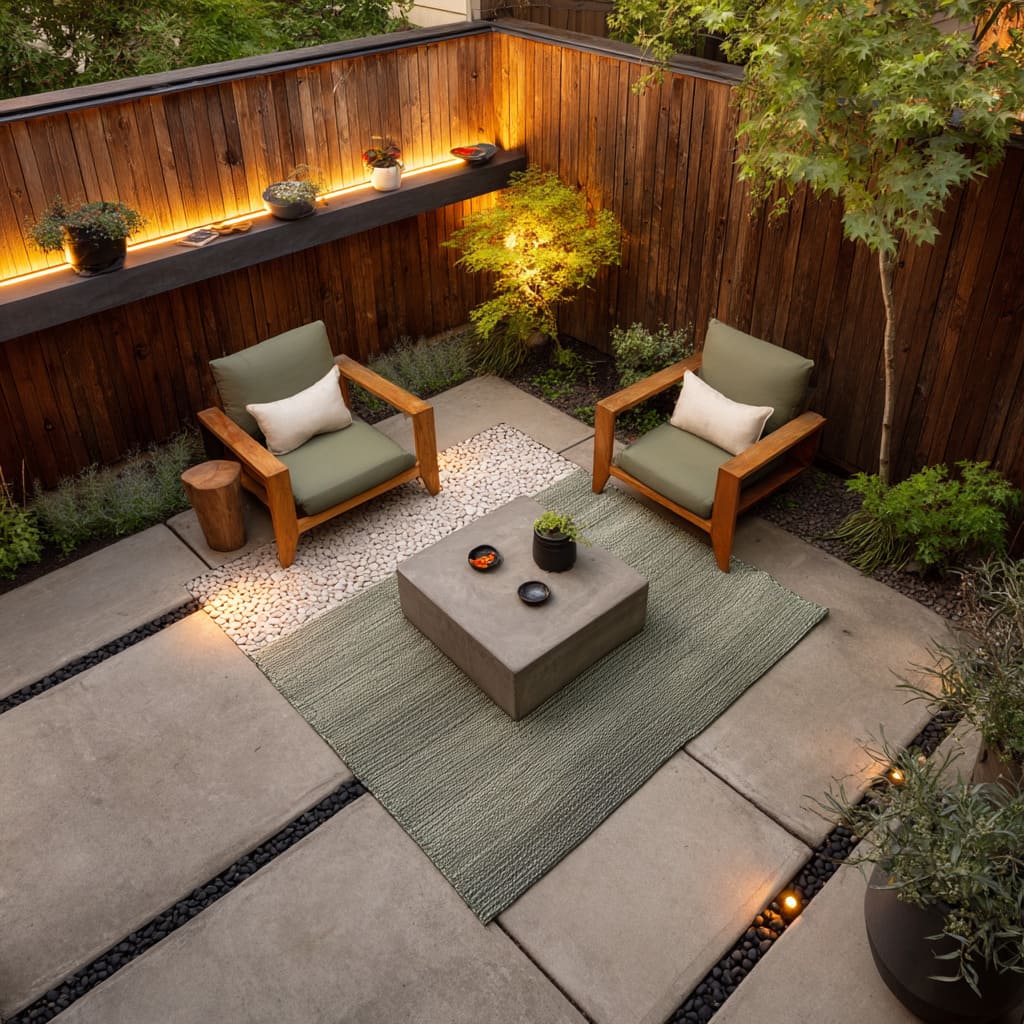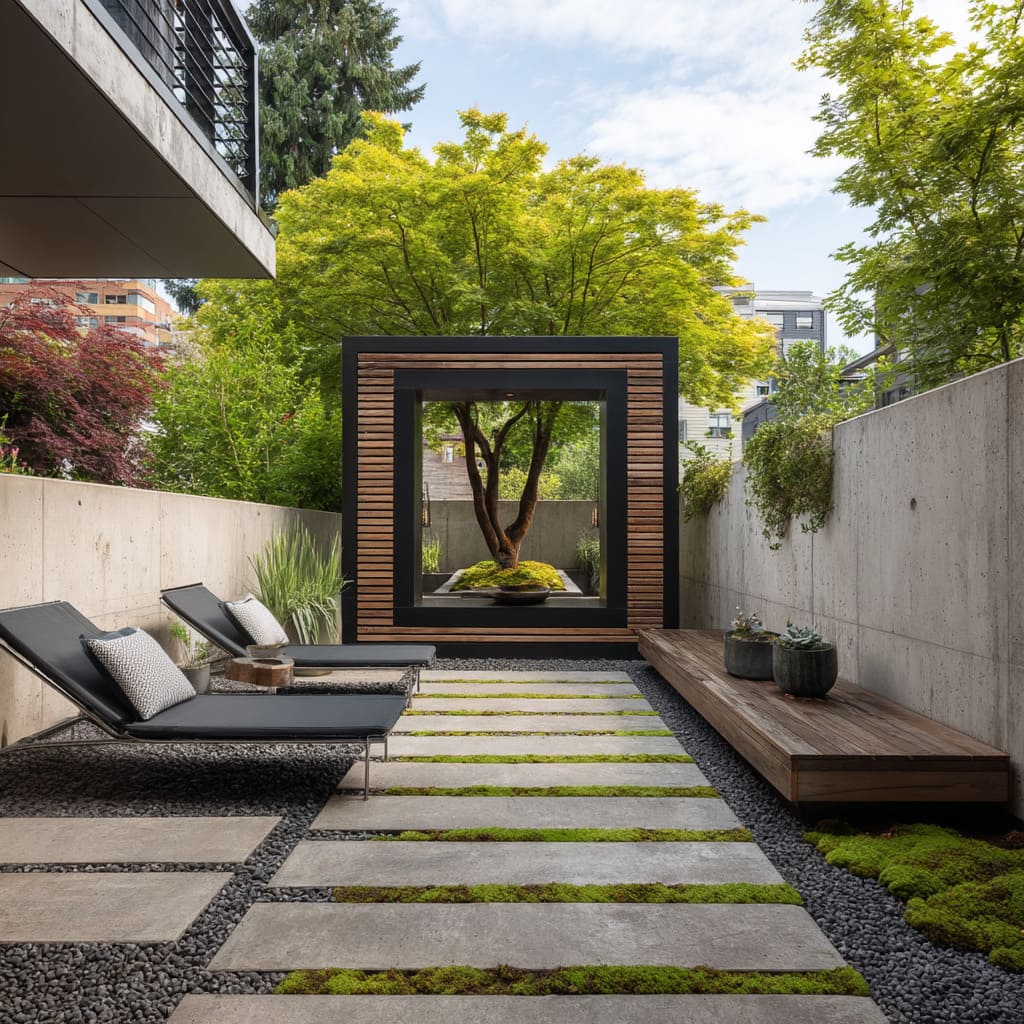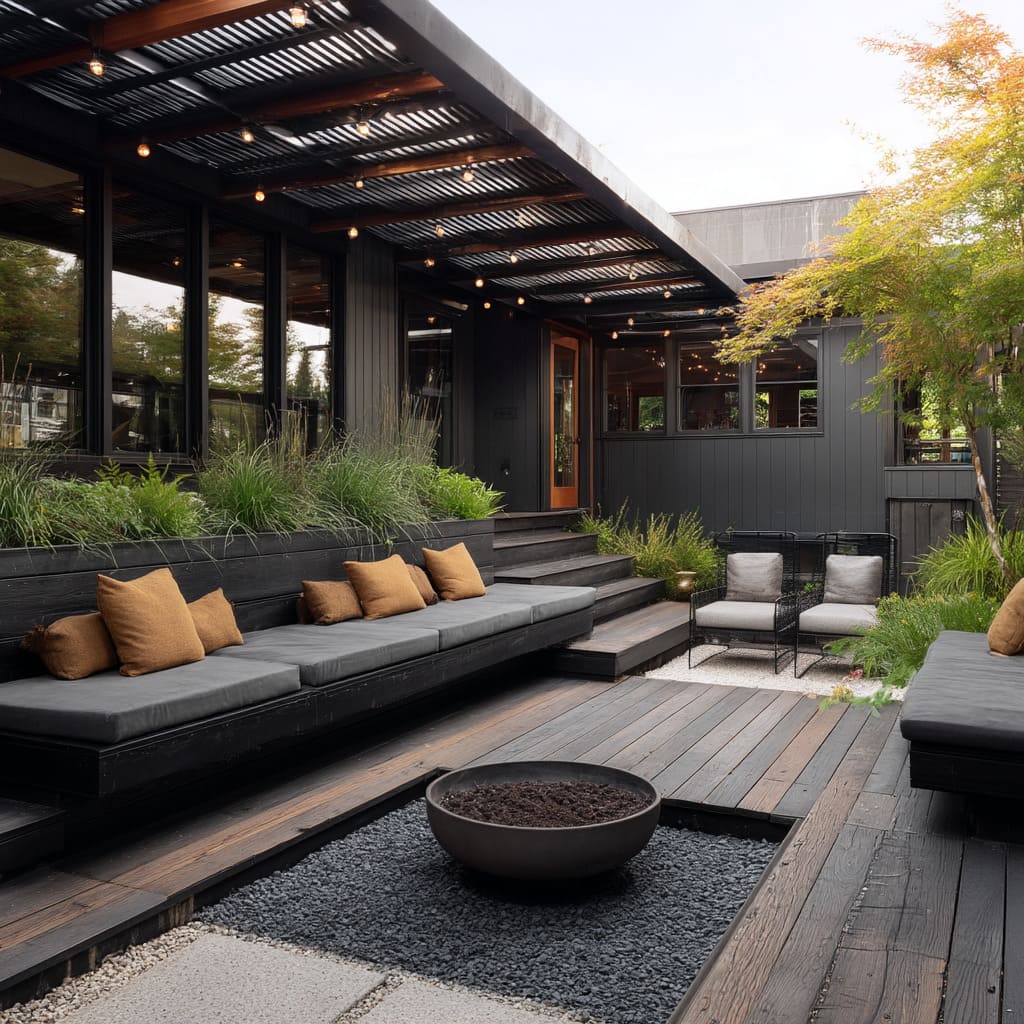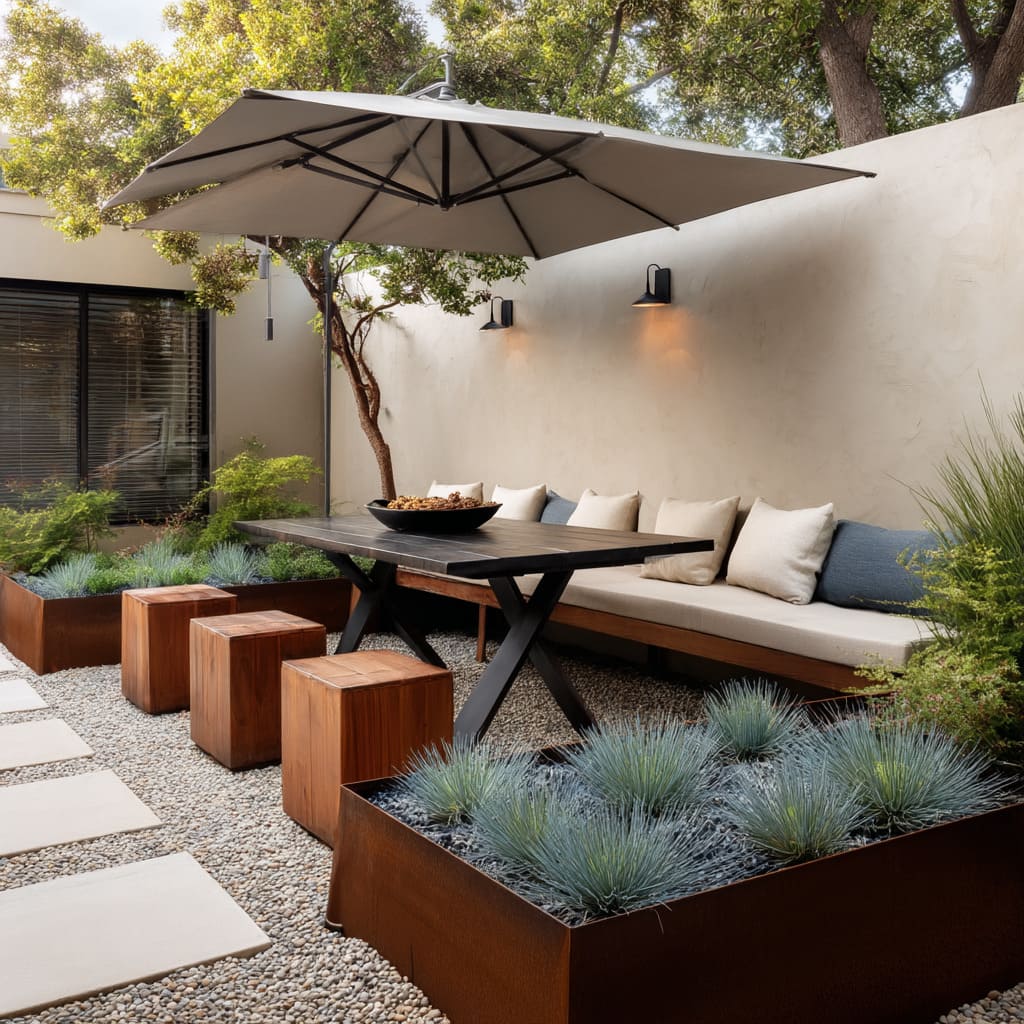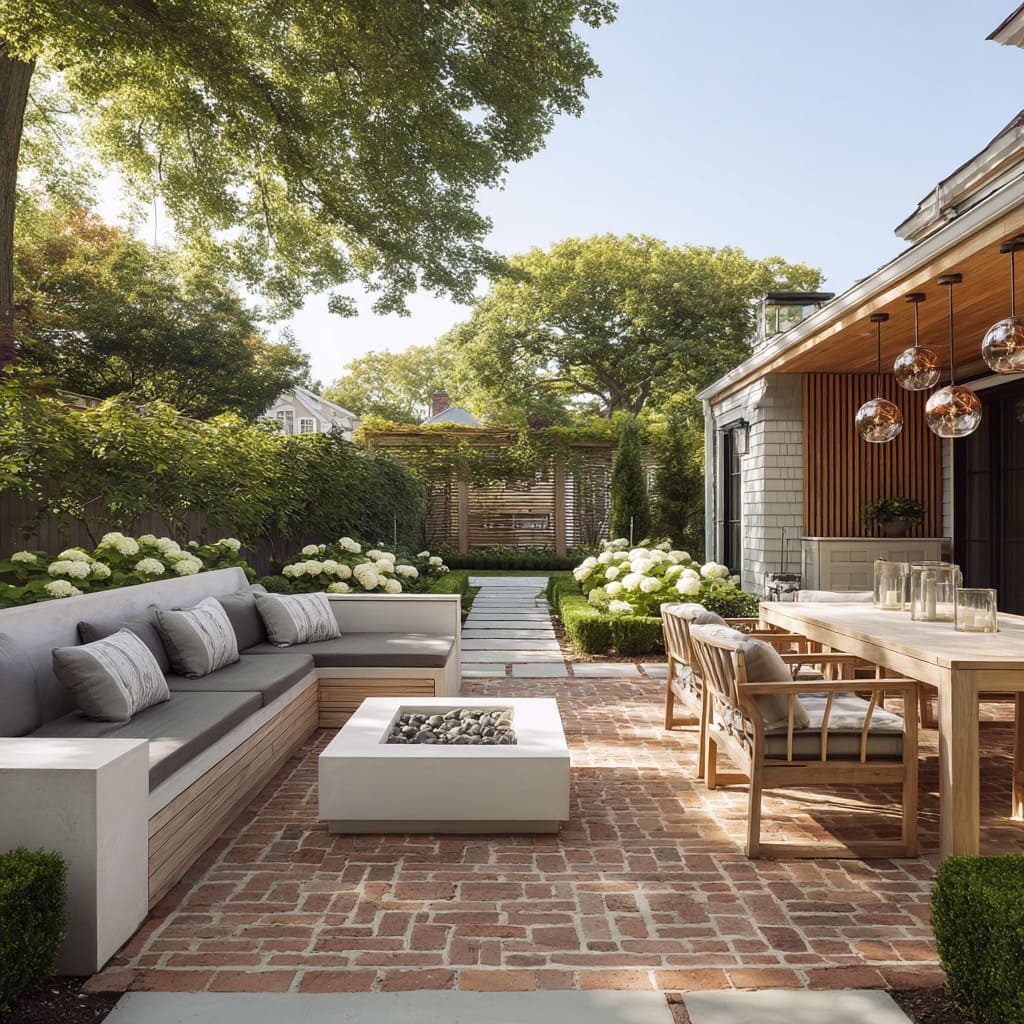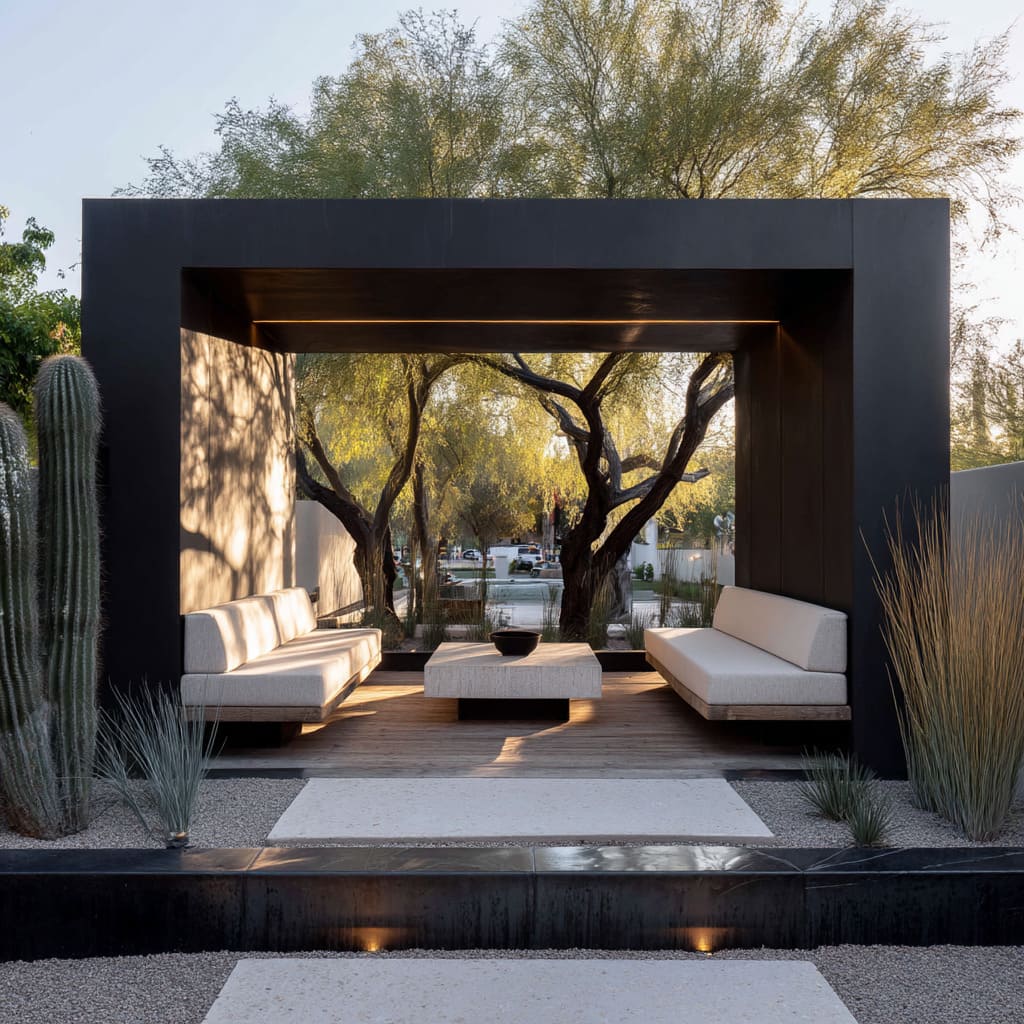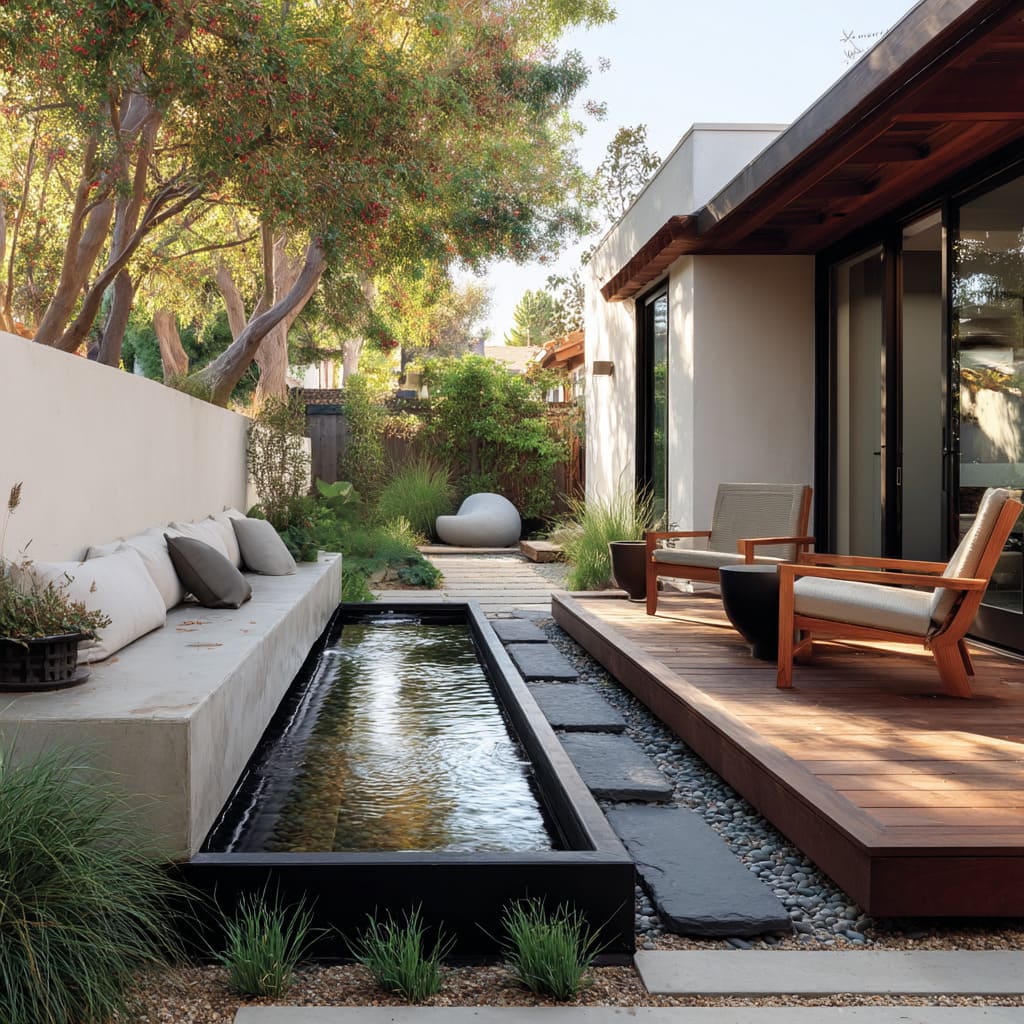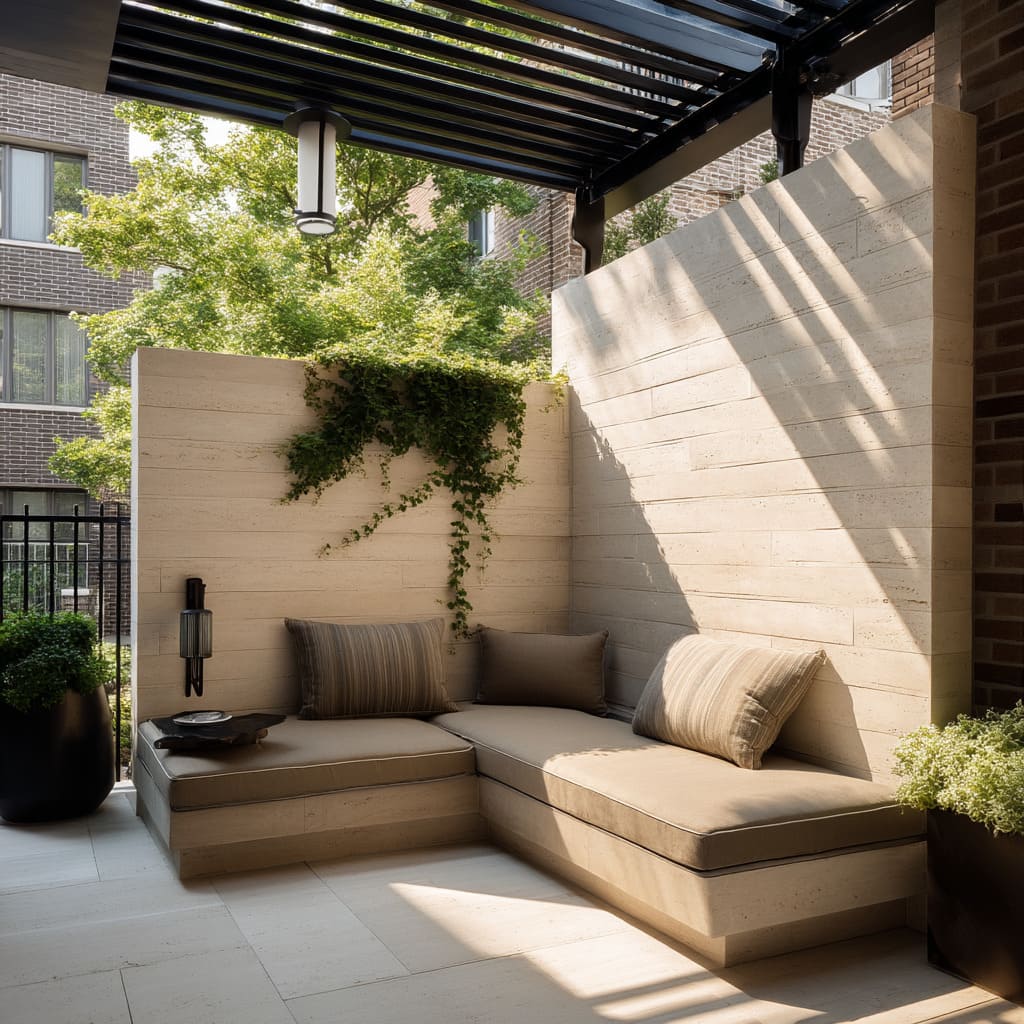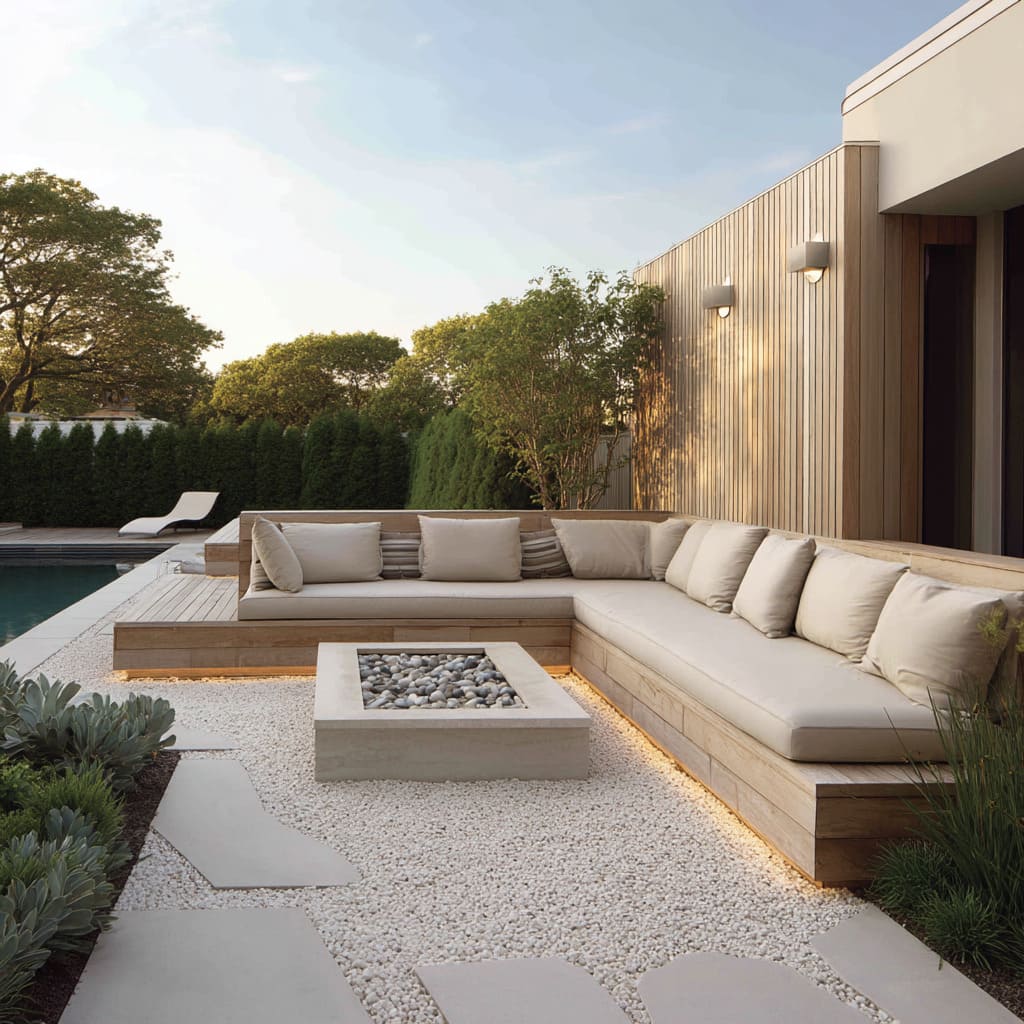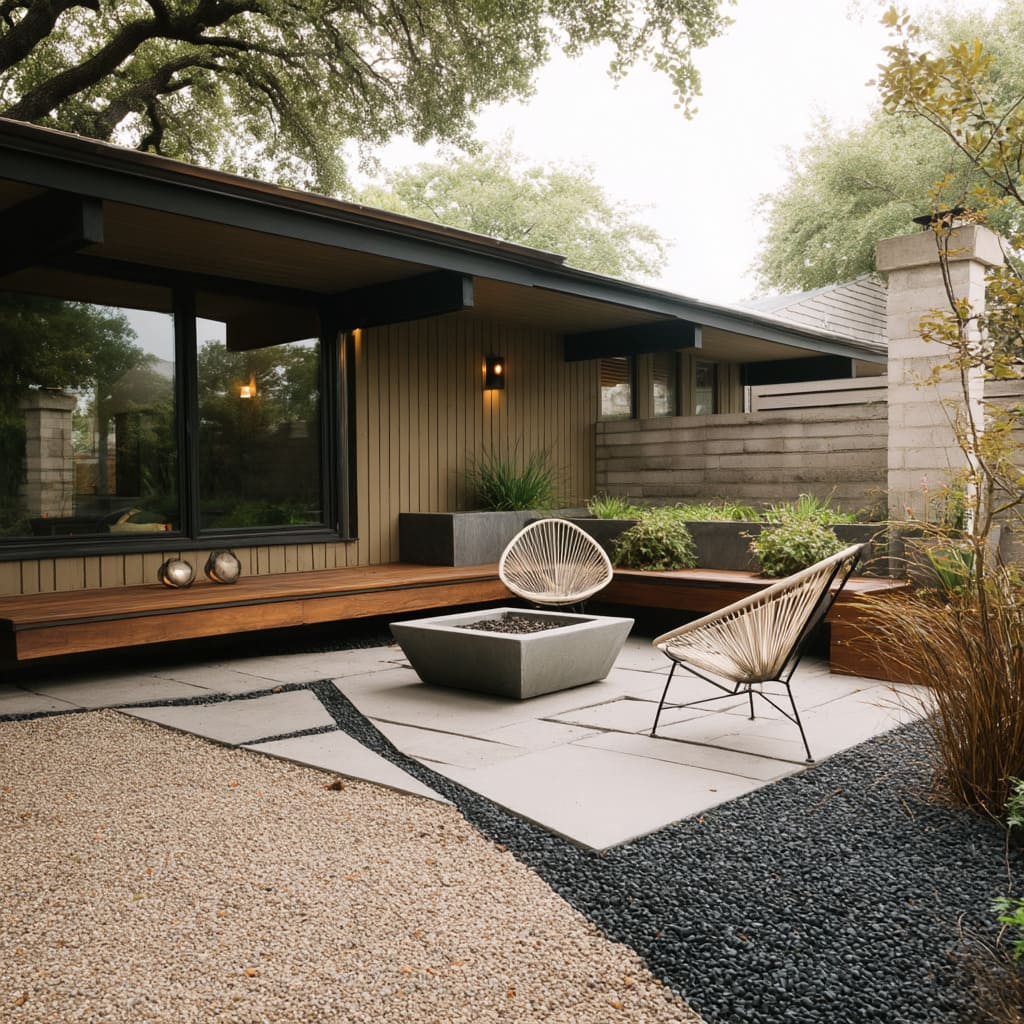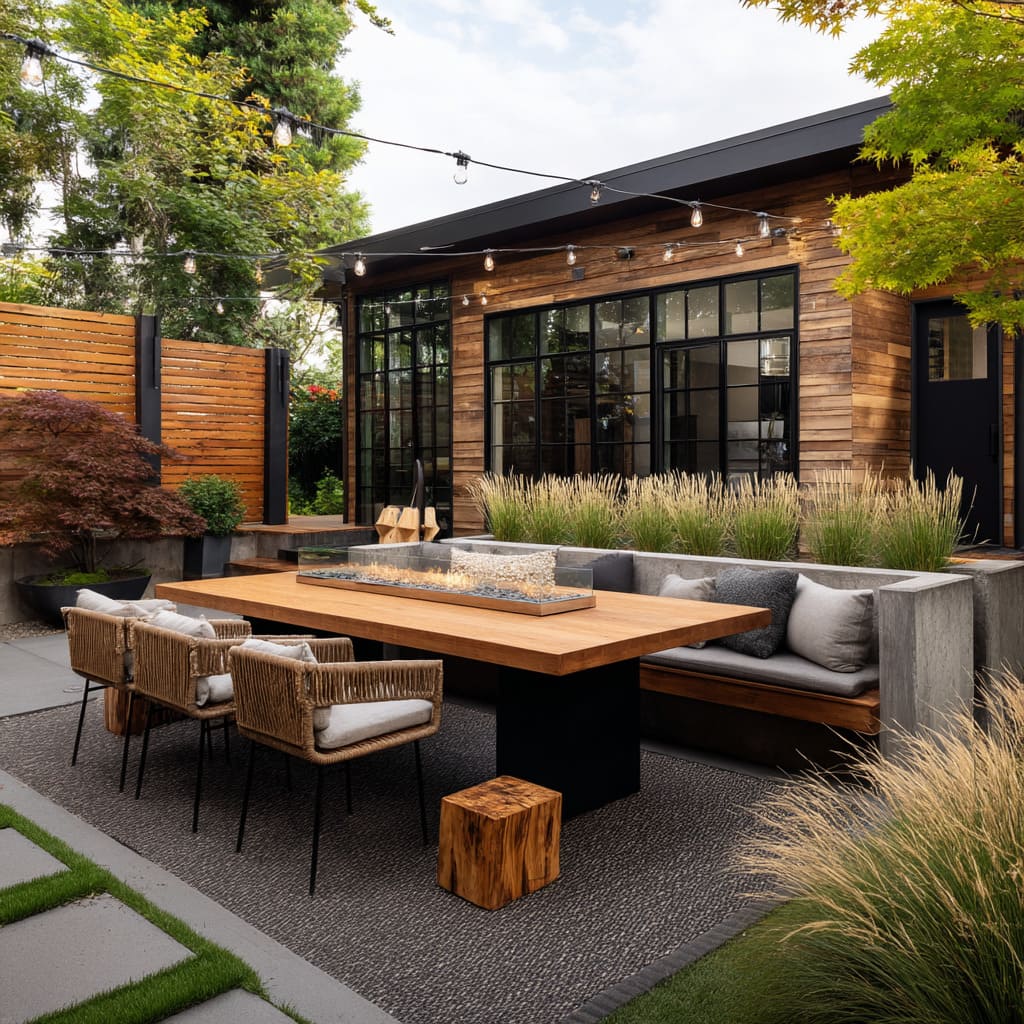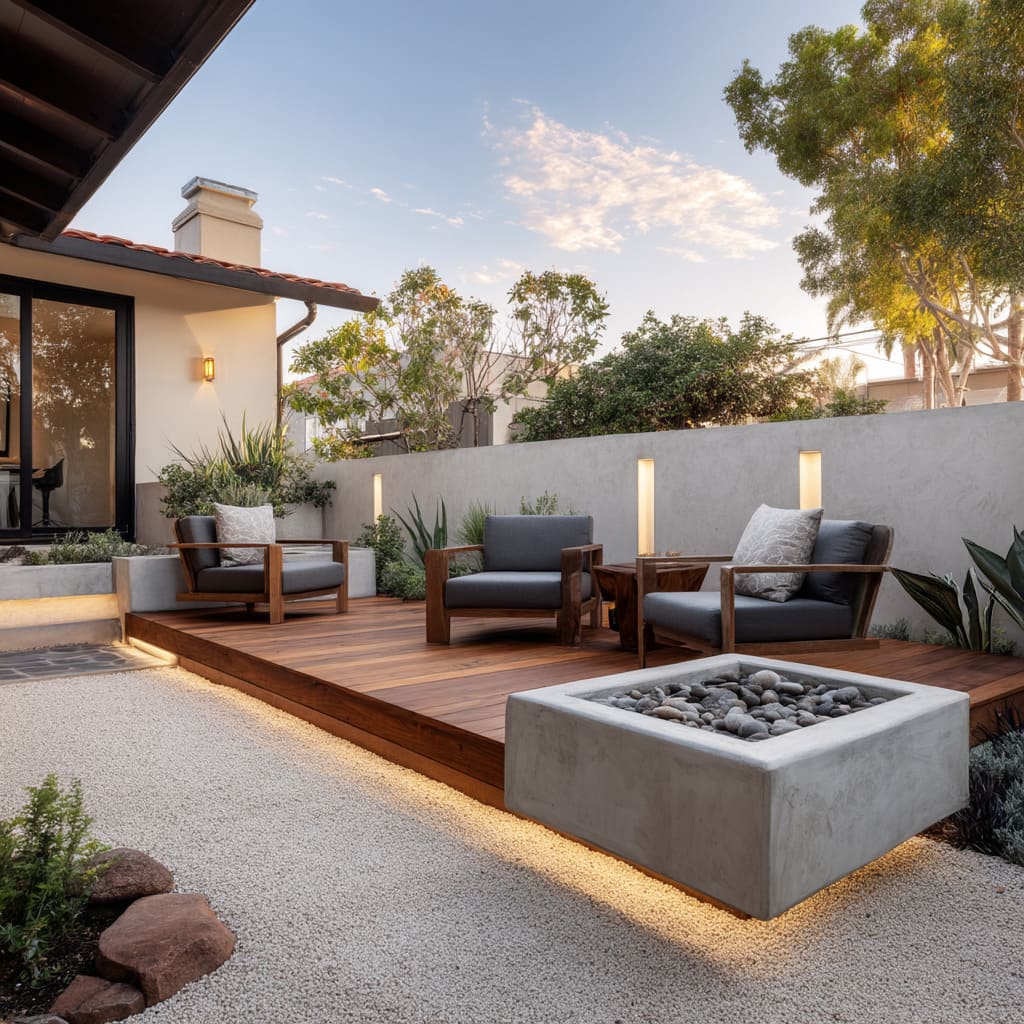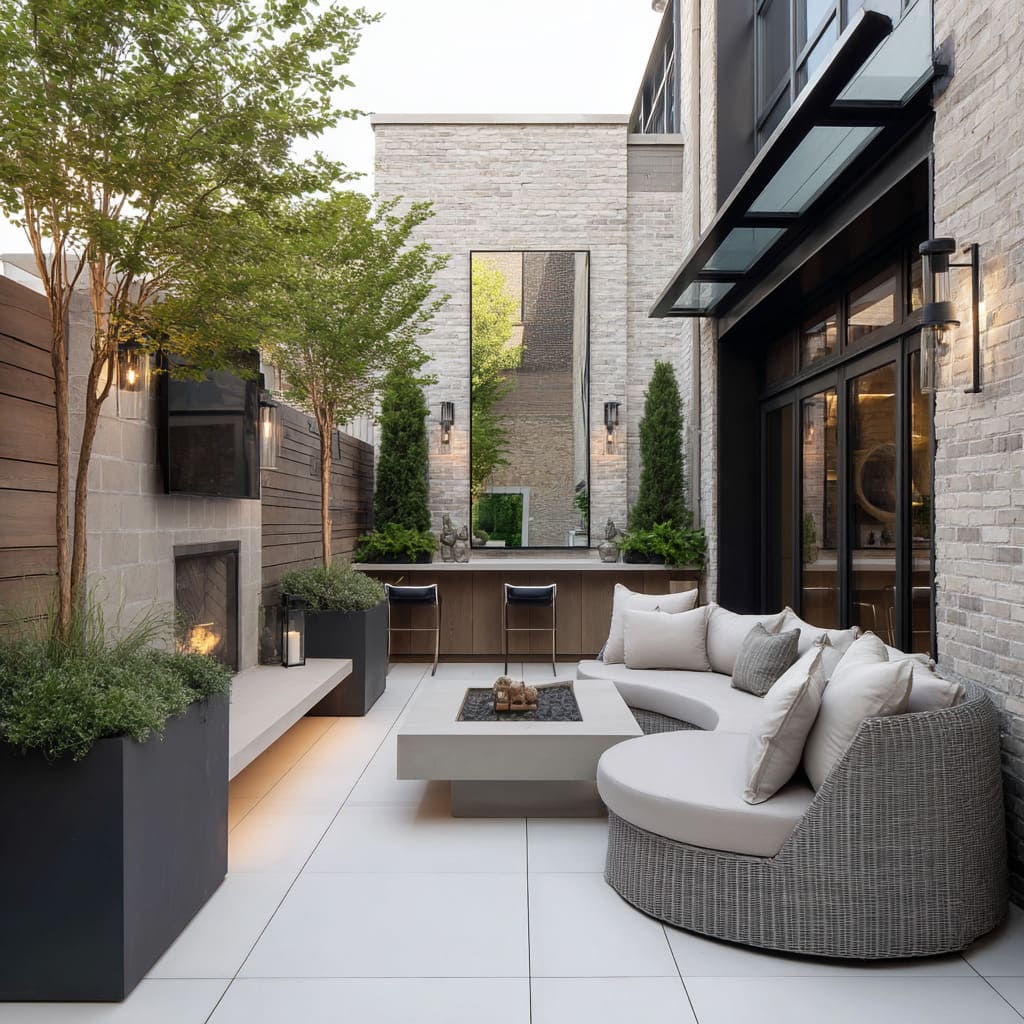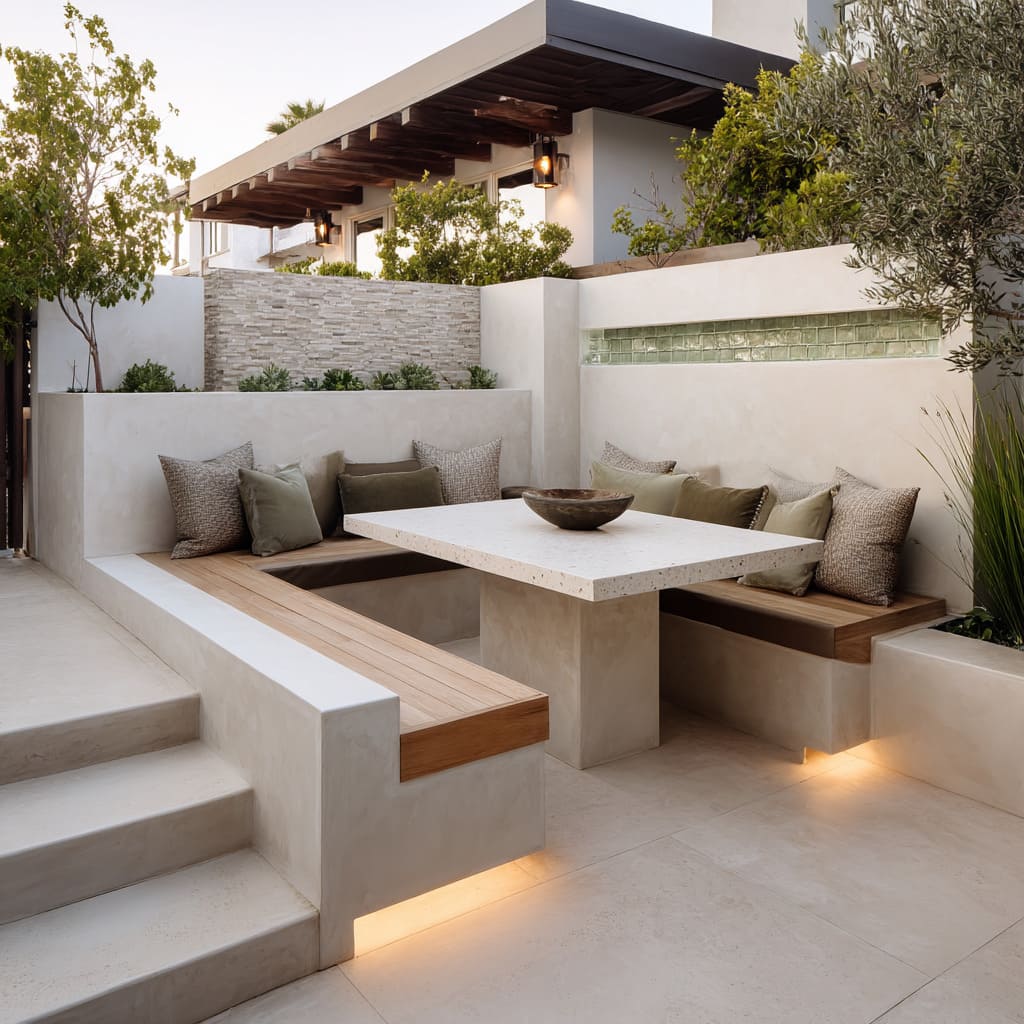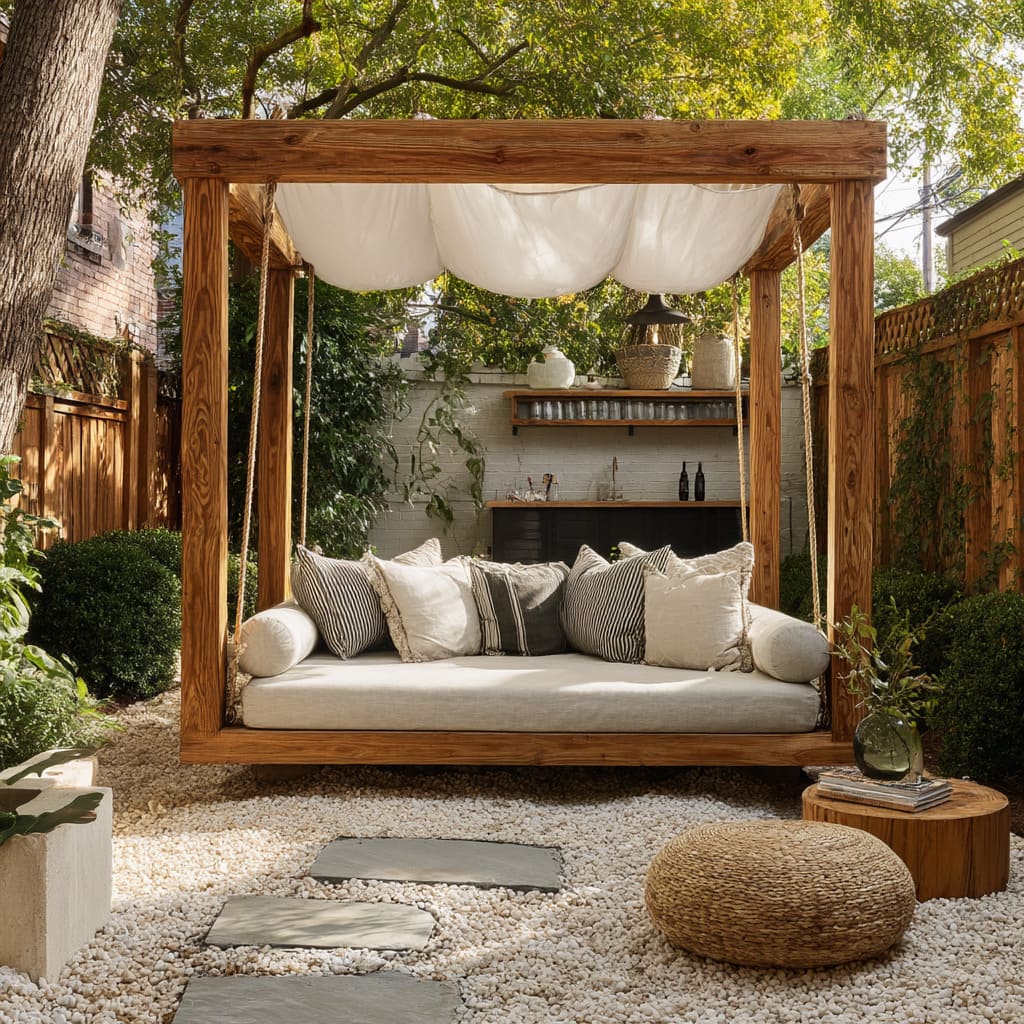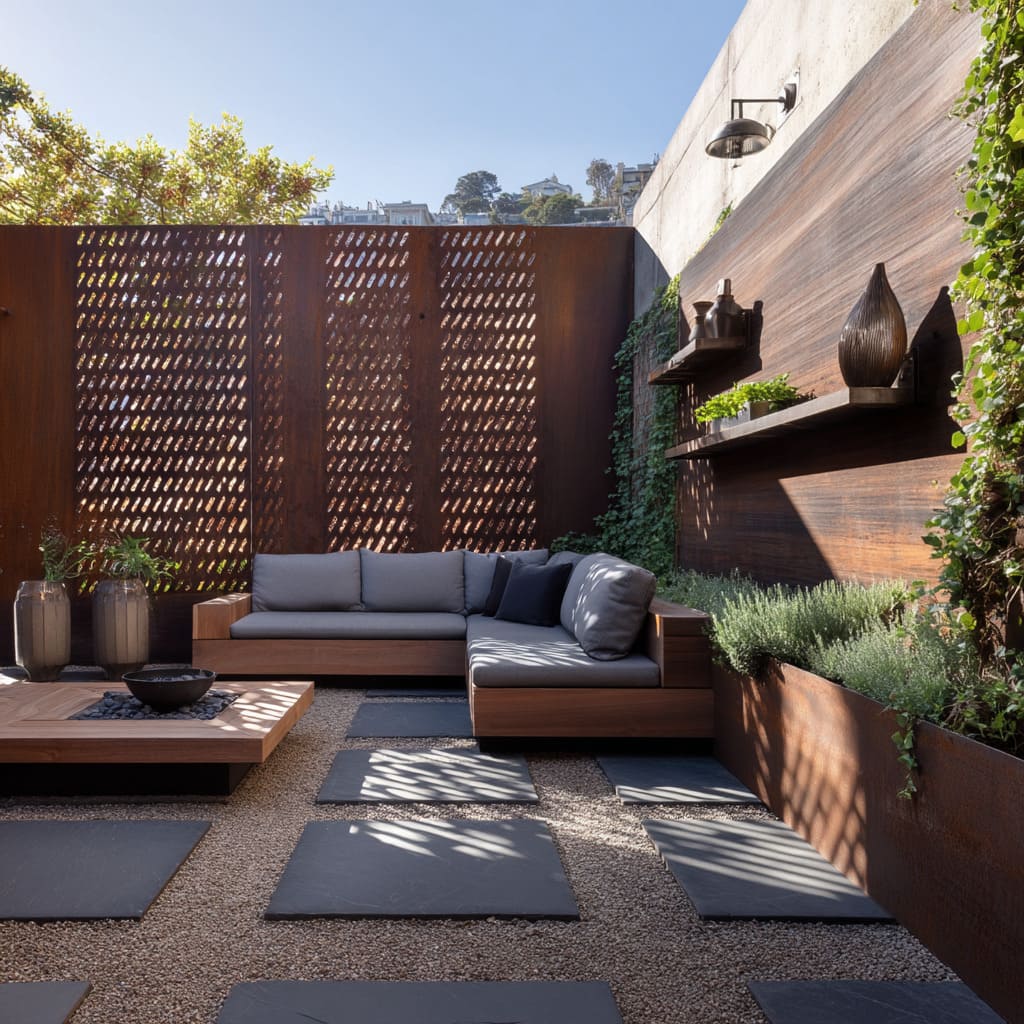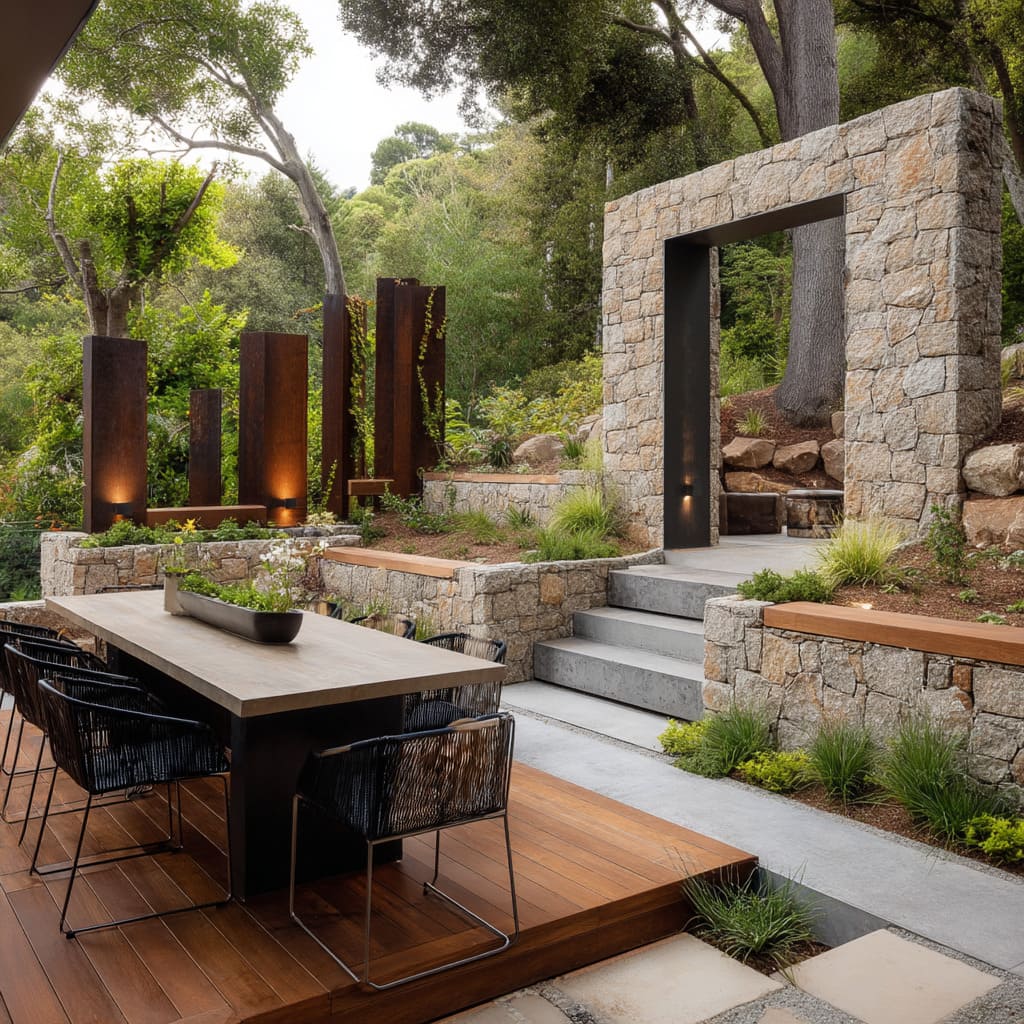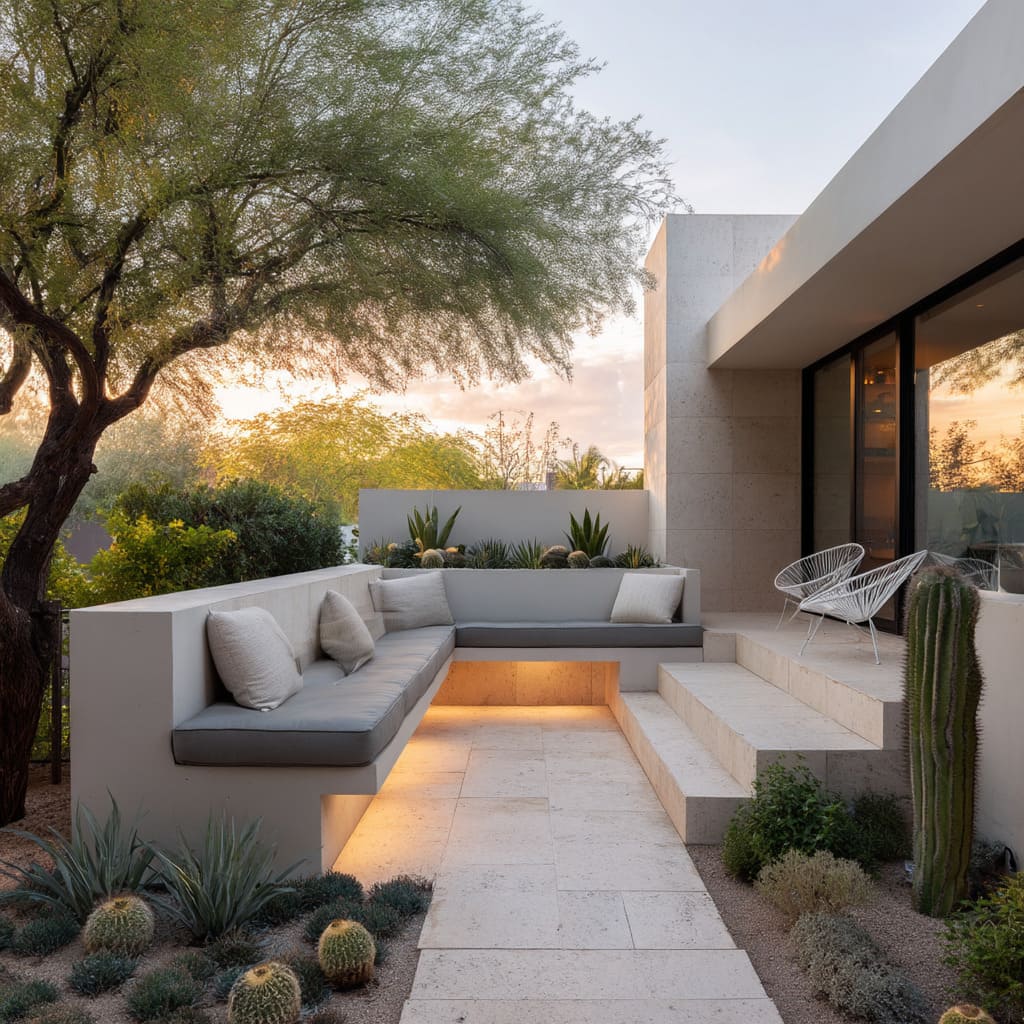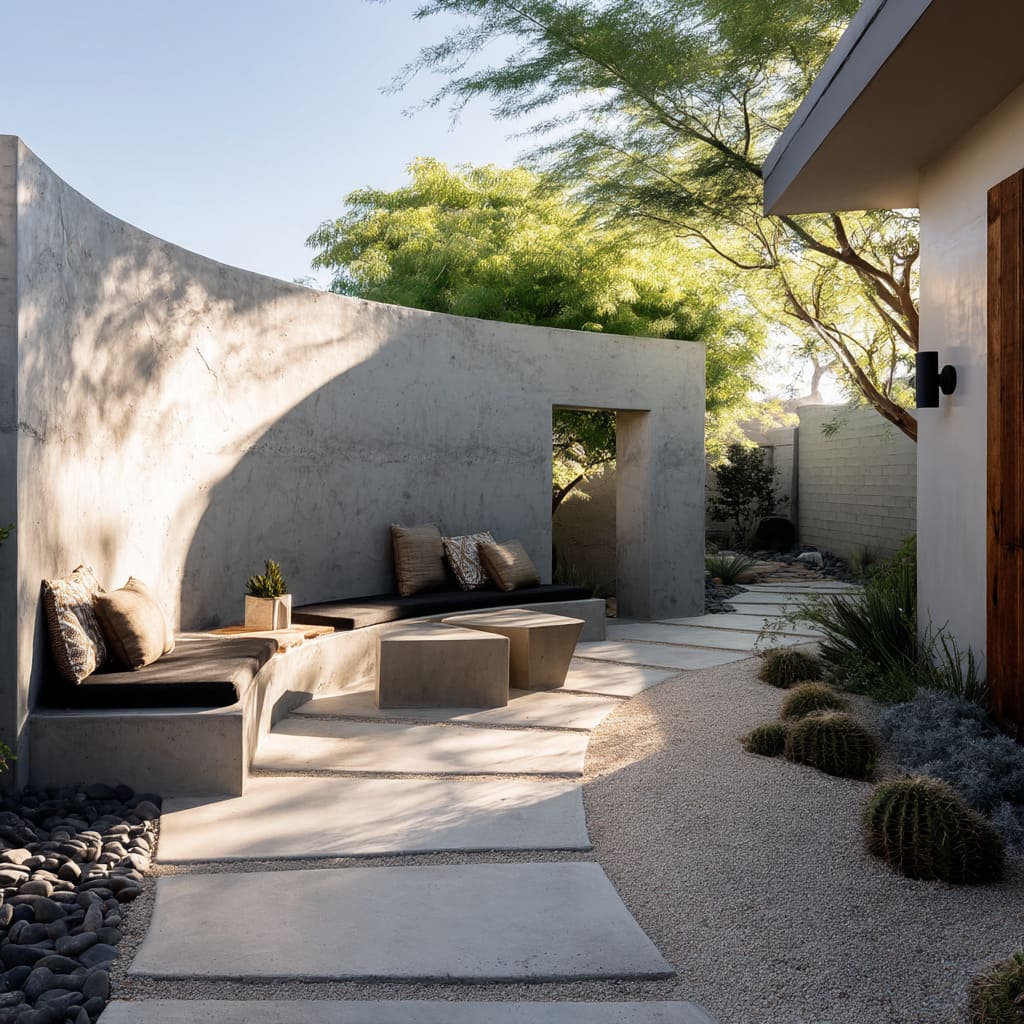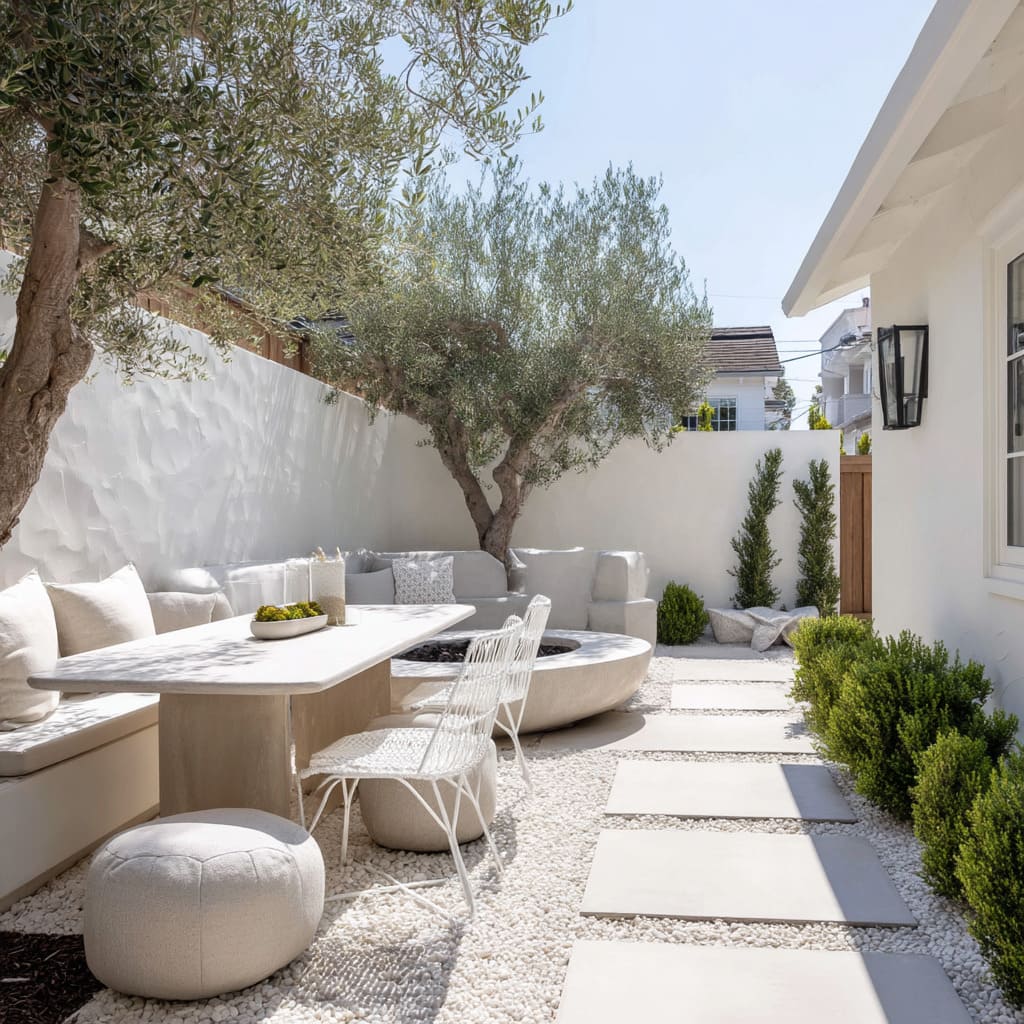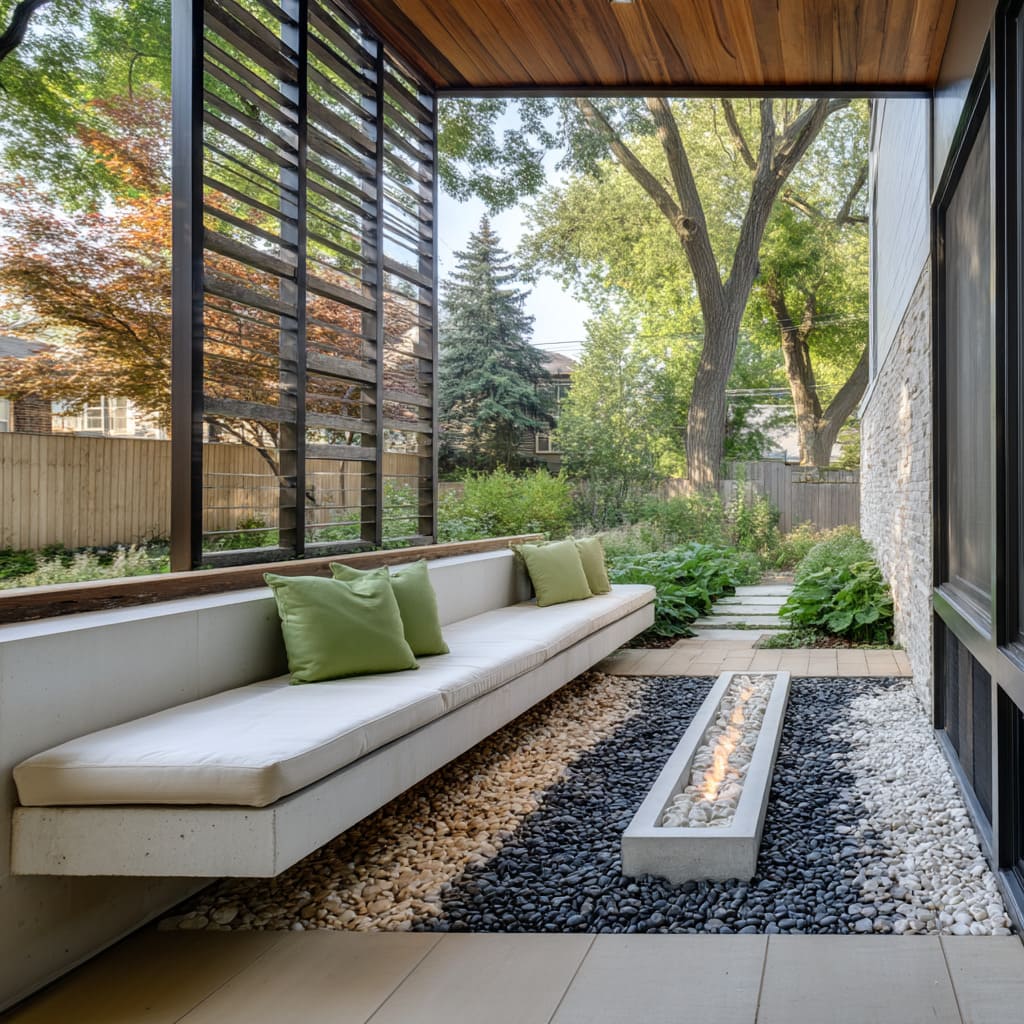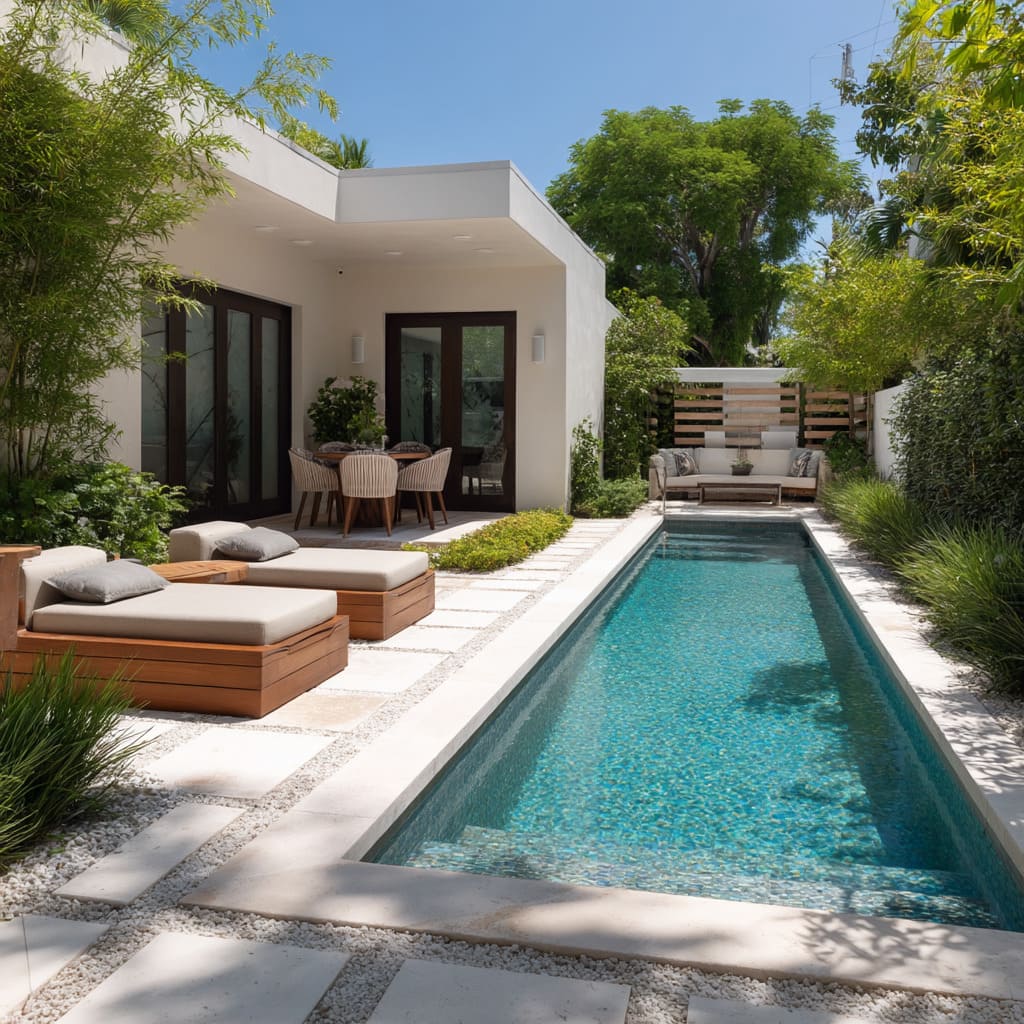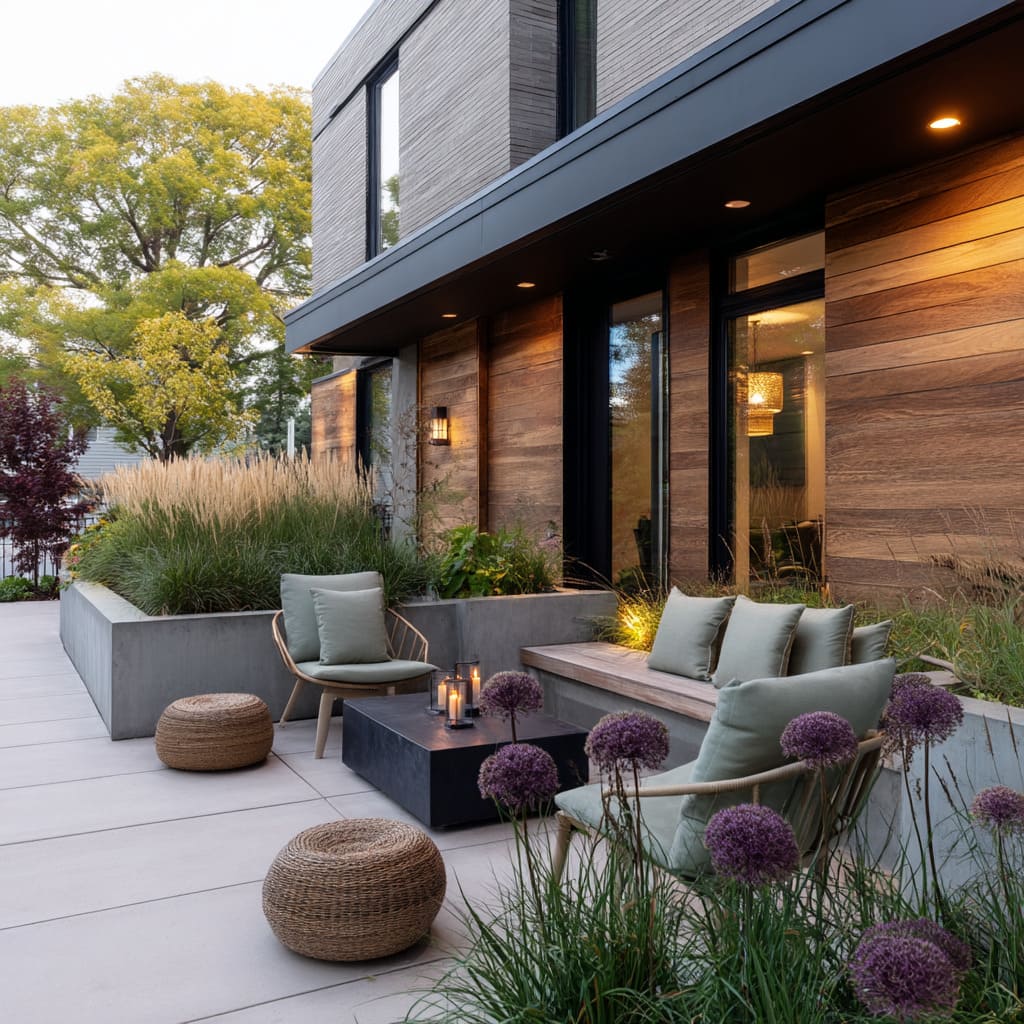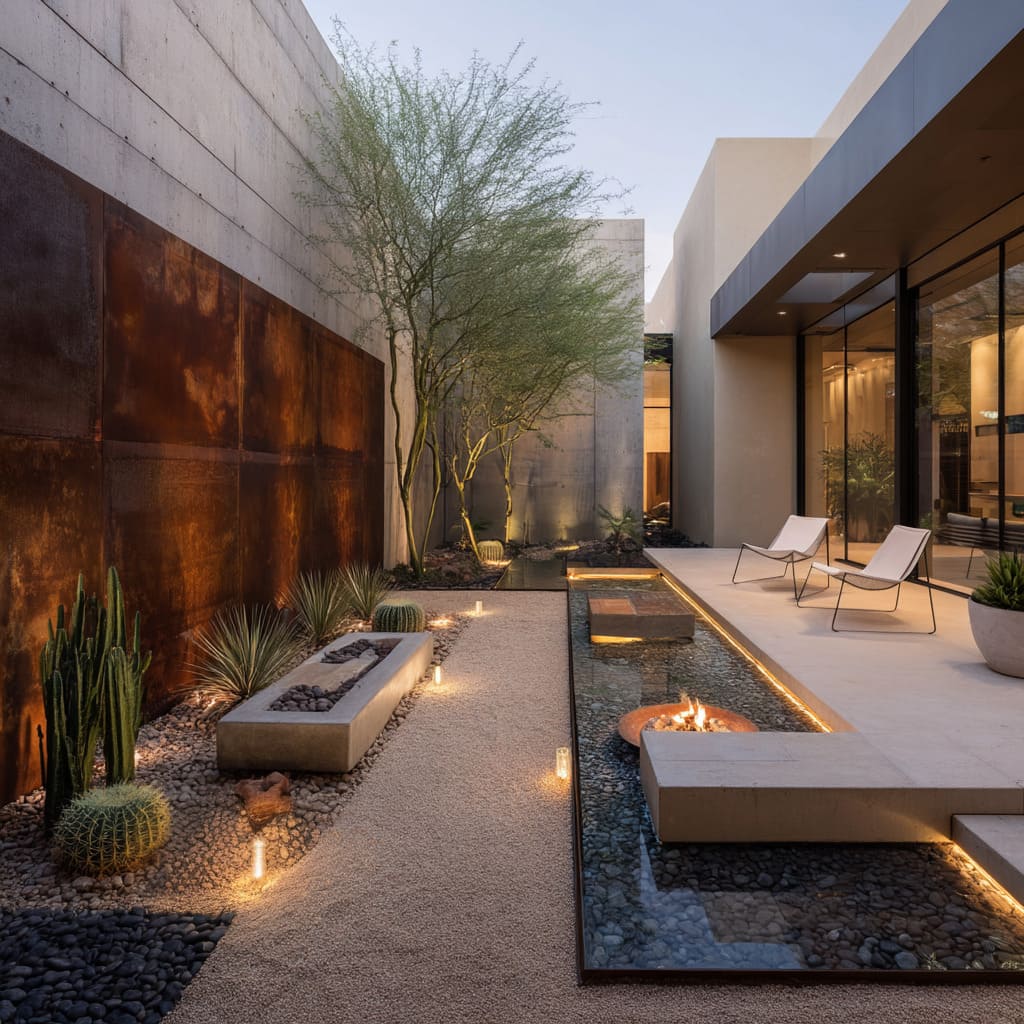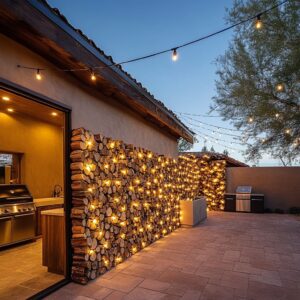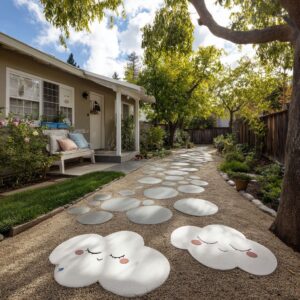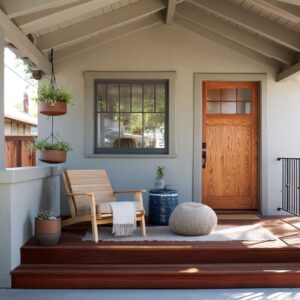Backyards today are less about decoration and more about visual clarity, material rhythm, and spatial control. The latest modern landscape design ideas rely on composition that’s both restrained and exact.
It’s no longer about piling on features or dramatic plants. Instead, the focus has shifted to subtle decisions—where a bench begins, where a path bends, how a surface meets its edge without trim.
Texture, light, and proportion lead the mood. Grass may act as a frame, not a field.
Shade is used as a drawing tool, not just a shelter. Surfaces change gradually, and colors are stretched through tone rather than contrast.
These aren’t spaces filled to the edges. They are shaped to hold stillness, openness, and repetition—allowing details like plant structure, paving lines, or a low flicker of fire to carry weight without shouting.
This approach works across many settings, from compact yards to layered terraces, and favors materials that can age well, shadows that add motion, and forms that appear lighter than they are. The goal isn’t to impress instantly—but to keep revealing small decisions the longer you look.
Each section of this article breaks down the moves that bring that kind of visual discipline to life.
Seating That Erases Itself
In many current backyard design ideas, seating is no longer presented as a standalone object. Instead, benches and sofas are worked directly into the bones of the layout—folded into planter walls, absorbed by low retaining edges, or tucked into terraced platforms.
This approach allows the space to remain visually quiet while still fully functional. At first glance, the seating may seem almost invisible, because the design allows surrounding textures—plants, ground finishes, or lighting features—to take priority.
The effect is like a landscape that breathes on its own, without the usual clutter of separate elements.
The visual impact lies in subtle detail. Cushions take on a role closer to color accents rather than full objects—they sit lightly against neutral surfaces, like brushstrokes rather than furniture.
Where shadow gaps are placed below seat slabs, the benches seem to float slightly, breaking their weight and helping open up the floor plane. This sense of lightness doesn’t come from thinness or fragility, but from proportion and spacing.
If the bench tone closely follows the surrounding surface—whether it’s concrete, wood, or stone—the seating blurs into the background. The composition then becomes unified, letting planted borders or art elements do the expressive work.
It’s a direction in backyard landscaping ideas that favors quiet visual clarity over object-based decoration.
Portal Thinking — Frames as Lenses
Some backyard designs use strong frame-like structures—whether literal or suggested—to shape how the space is seen. These frames aren’t ornamental.
They’re thick, deliberate, and purposefully placed. The surrounding material might be timber, metal, or even planted hedging, but the intention is always the same: to turn an open void into something felt.
Instead of gazing across the whole yard at once, the eye is pulled through a portal, narrowing focus before revealing more.
The effect of this is striking without being loud. What was once empty space becomes a focal form that changes with the season, the weather, or time of day.
Heavy borders narrow the field of view, trimming out visual noise like a photographer’s crop tool. This approach doesn’t just guide attention—it organizes it.
When paving seams or low fire strips run directly in line with these framed zones, the depth of the space feels multiplied. Even narrow plots can seem stretched, as the frame pulls the viewer’s gaze farther than the yard’s actual dimension.
This visual play is especially powerful in small urban courtyards or linear lots, where clear structure helps maintain a sense of calm and clarity. Together, these ideas help define a style of backyard design that values composition over clutter—where the restraint of built-in forms and the focus offered by sculptural framing create outdoor spaces that feel both open and composed.
Float Illusion via Underglow
Lighting beneath seats, platforms, or ledges has become a defining gesture in modern backyard landscaping. Instead of aiming light outward or upward, which risks glare or distraction, these setups direct a subtle glow downward—along the base of concrete benches, timber decks, or recessed platforms.
The result shifts attention from the source to the effect. Viewers don’t see the bulb; they see the object gently lifting from the ground.
This is where the magic starts to happen visually. Large, weighty elements—solid blocks of concrete or extended seating slabs—begin to feel buoyant after sunset.
The contrast between warm-toned light and cool stone creates a fine edge of halo around each form, softening otherwise rigid outlines. This isn’t ambient lighting in the traditional sense; it’s a visual device that redraws how mass and ground interact.
Because the glow comes from hidden channels, the rest of the space remains clean, with no exposed fixtures competing for attention. Shadows fall precisely where they should—away from faces, across texture-rich gravel, or behind dense foliage—preserving the calm composition of the yard.
It’s a quiet but powerful move, often seen in backyard landscaping plans that value structure and atmosphere over overt decoration.
Quiet Colour Twins & Near-Neutrals
Instead of stacking sharp contrasts or bold accent splashes, many refined landscaping ideas lean into single-hue variation. One tone is taken and expanded across a full spectrum of materials and elements.
A green can show up in plant leaves, bench cushions, and the underside of pergola beams—but in different intensities, from pale sage to deeper olive. Rust tones may stretch from a corten planter to a wood pergola beam with embedded lighting.
Even beige—often overlooked—shifts subtly from stone slab to gravel joint and cushion trim. The impact is stronger than it first seems.
Using one hue across a broad range of values makes the space feel layered, not loud. It draws the eye to shifts in texture, proportion, and shadow instead of forcing attention on contrast alone.
This approach invites the materials to do the work. Smooth concrete, rough stone, lightly brushed wood—all take on extra depth when the colour underneath them is linked.
This technique also carries practical visual value. Near-neutrals weather gracefully.
As surfaces patinate or catch sun over time, the variations appear intentional—less like wear, more like richness. Even with daily use, the yard holds onto its clarity.
These palettes are especially common in high-end backyard design schemes where subtlety carries more weight than saturation. By drawing cohesion from tone rather than intensity, the result feels balanced and long-lasting—quiet in its presence but never flat.
Shadow as Ornament
In modern backyard landscape design, shadows aren’t an afterthought—they’re part of the plan. Structures like slatted pergolas, perforated corten steel panels, and breezeblock walls do more than provide coverage; they shape the light itself.
These elements cast shadows that move throughout the day, layering the surfaces below in shifting patterns. This light play creates atmosphere without extra objects.
Walls that might otherwise need art or plants become active participants, animated by sun and time. As the sun shifts, crisp lines fall across stone floors, benches, or even water surfaces, creating a subtle performance.
In climates with strong sun, these dense shade intervals offer visual comfort. Bright surfaces nearby appear cleaner and sharper by contrast.
There’s also an underlying rhythm at play—thin shadow lines repeat across decking seams, fence boards, or upright planting. Even if viewers don’t consciously track it, their eyes recognize the consistency.
The space feels ordered, but not rigid. It’s this soft structure—built from repetition and filtered light—that makes a patio or courtyard feel composed without clutter.
This use of shadow aligns with some of the most refined landscape design ideas, where atmosphere is built from what isn’t physically there.
Textural Gradients—Not Blocks
Rather than dividing zones with hard shifts in surface—say, stone to gravel with a clear line—many current layouts use gradual transitions. Moss may run between wide concrete slabs.
Gravel might fade from pale beige to rich brown as it nears a feature wall. River pebbles can mix sizes and tones across a stretch of ground, building layers without lines.
This makes the space easier to look at and longer to observe. The eye doesn’t stop—it glides.
These transitions smooth out the visual path, giving the space a sense of depth that goes beyond physical dimension. Instead of abrupt breaks, the materials blend, drawing attention to what changes slowly: scale, tone, and reflectivity.
Viewers tend to linger longer because their gaze isn’t blocked by borders.
The gradients also work practically and visually. Leaves or dirt that settle into these surfaces don’t read as mess—they become part of the palette.
This visual generosity keeps the space feeling clean without being precious. In the context of thoughtful backyard landscaping, it’s a way to stretch the mood of the space using only materials underfoot.
And because gradients connect areas softly, they support layouts that feel quiet, even when the design is rich.
Plant Architecture over Plant Variety
Instead of filling outdoor spaces with color-saturated blooms or seasonal surprises, many modern layouts lean into plant shapes as structural tools. What reads strongest in these gardens is form—how stems rise, how leaves spill, how clusters repeat.
This approach focuses less on variety and more on how each plant contributes to the physical rhythm of the space.
One standout move is the repetition of form. A row of barrel cacti can echo a nearby curved seating wall, creating a quiet visual rhyme.
Tall vertical herbs like rosemary or bamboo reinforce the lines already set by fences or pergolas—linking living elements to the built frame. And in softer corners, long grasses spill over ledges, planter walls, or bench backs, blurring sharp transitions like a shadow softening the edge of a structure.
The overall impression is clarity, not chaos.
These choices allow the garden to act like a controlled relief: hard materials give geometry, and plants give mass, blur, and texture. Even slight seasonal shifts—leaf tone changes, blooming phases, or the way wind moves foliage—stand out clearly against the pared-down setting.
This method works especially well in small backyard landscaping ideas, where visual clutter can quickly overpower a limited space. It’s less about collecting species and more about composing with shape.
Groundplane as Graphic Art
Modern gardens often shift the focus downward—treating the ground as a visual surface rather than just a place to walk. Grid patterns formed from concrete slabs and grass joints, angled stone planks set in gravel, or terrazzo-effect tiles placed with wide seams are common moves.
These patterns act like large-scale artwork that only becomes apparent when seen from above or across.
Lines are the hidden directors.
Whether it’s step paths slicing diagonally across a lounge deck or a paver grid under an outdoor dining table, viewers subconsciously follow these lines, which stretch or widen the perceived space. A narrow yard can appear longer just by the direction of a seam.
A compact dining area can feel broader when the pattern runs laterally across the floor.
What’s placed above the ground benefits too.
Chairs with open bases or slim legs float better above large slabs, where the surface isn’t interrupted. Tree shadows, planter boxes, and even seating silhouettes echo the patterns below, layering harmony without repeating materials.
This attention to layout depth adds quiet refinement, particularly in yards where every surface counts. It’s an approach seen often in thoughtful garden landscaping ideas—where floor treatment isn’t leftover space, but part of the composition itself.
Mirrored & Water Reflections as Volume Doublers
Some of the most visually impactful modern landscaping ideas come not from what’s added—but from what’s echoed. Mirrors and water surfaces are used to make tight spaces stretch, not by changing the boundaries, but by reflecting them with precision.
These elements don’t add space physically—they borrow it from sky, light, and greenery, and hand it back as illusion.
- A vertical mirror fixed flush to a garden wall can do more than bounce back a view. It creates the illusion of an open corridor where there’s none. It lifts height by reflecting fence lines upward, allowing courtyards to feel less enclosed. And when framed cleanly with no trim, the mirror becomes part of the architecture—not a decoration, but a plane of visual space.
- A still water surface works horizontally in the same way. At dusk or night, firelight doubles across the reflection, flickering upward while remaining low in reality. Tree branches appear to float, stars land in the pool, and soft uplighting picks up two lives instead of one. For both strategies, the absence of edge clutter is crucial. No coping lip, no paver overhang, no hardware interrupts the reflective surface. That’s what gives it the infinite effect.
This principle is particularly effective in small yard landscaping, where visual expansion has to be achieved without adding mass or structure. Done right, a mirror or a reflecting pool feels like a silent extension of the space—a depth that’s sensed, not built.
Furniture Transparency & Airflow
In outdoor spaces shaped by precision, furniture often pulls back rather than pushes forward. Wire-framed chairs, open-weave loungers, and slender-leg tables are chosen not only for their comfort or shape but because they allow light and air to pass through, keeping the layout from feeling blocked.
Such design move has a subtle but strong effect. The paver layout or gravel pattern underneath remains visible.
That’s important—because ground surfaces in these yards are often treated like visual fields. Letting them show through the furniture keeps the graphic integrity intact.
Shadows from foliage or fence slats continue across seat cushions, rather than being interrupted by bulky forms. Even large elements like fire tables or centerpieces feel lighter when surrounded by pieces that don’t wall them in.
An oversized table in the middle of a gathering zone can remain the visual anchor without overpowering the scene—so long as the chairs around it allow for visual breathing room.
This attention to visual openness adds to the rhythm of the space. In many outdoor layouts, especially those built around modern landscaping ideas, it’s the negative space—the gaps, the air, the see-through moments—that brings the entire composition to life.
Conclusion
The strongest impressions in outdoor spaces rarely come from what’s shouted—they come from what’s carefully placed, what’s left open, and what’s chosen to stay quiet. Across all these examples, the clearest theme is control through subtlety.
A bench carved into a planter wall. A mirror that pretends to be a window.
A concrete slab that seems to float just above its own shadow. These aren’t technical tricks—they’re visual choices that reshape how a yard is read.
Each decision—to match materials edge to edge, to allow light to skim rather than blast, to build in rhythm through ground texture or slender shadows—adds to a larger effect. It’s less about filling space and more about how space holds itself.
And in many of the most thoughtful layouts, the loudest voice comes from restraint: one colour stretched across tones, one fire line stretched across seating, one material doing the work of two.
These are not decorative extras. They are structural cues to how the eye moves and rests.
They’re the difference between a yard that’s looked at and one that’s quietly returned to. Even in tight footprints or compact plots, these decisions create breathing room—not by adding more, but by refining what’s already there.
This is where modern backyard landscaping ideas set themselves apart. Not in the number of features, but in how each part participates in the larger composition.
With every softened shadow, low-slung bench, and reflected sky, the yard becomes not just usable—but visually calm, grounded, and quietly complete.
